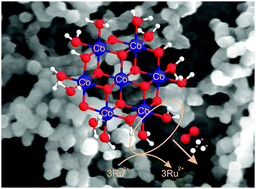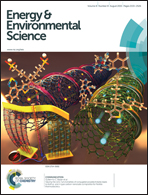First turnover analysis of water-oxidation catalyzed by Co-oxide nanoparticles†
Abstract
Co-oxides are promising water oxidation catalysts for artificial photosynthesis devices. Presently, several different proposals exist for how they catalyze O2 formation from water. Knowledge about this process at molecular detail will be required for their further improvement. Here we present time-resolved 18O-labelling isotope-ratio membrane-inlet mass spectrometry (MIMS) experiments to study the mechanism of water oxidation in Co/methylenediphosphonate (Co/M2P) oxide nanoparticles using [Ru(bpy)3]3+ (bpy = 2,2′-bipyridine) as chemical oxidant. We show that 16O–Co/M2P-oxide nanoparticles produce 16O2 during their first turnover after simultaneous addition of H218O and [Ru(bpy)3]3+, while sequential addition with a delay of 3 s yields oxygen reflecting bulk water 18O-enrichment. This result is interpreted to show that the O–O bond formation in Co/M2P-oxide nanoparticles occurs via intramolecular oxygen coupling between two terminal Co–OHn ligands that are readily exchangeable with bulk water in the resting state of the catalyst. Importantly, our data allow the determination of the number of catalytic sites within this amorphous nanoparticular material, to calculate the TOF per catalytic site and to derive the number of holes needed for the production of the first O2 molecule per catalytic site. We propose that the mechanism of O–O bond formation during bulk catalysis in amorphous Co-oxides may differ from that taking place at the surface of crystalline materials.


 Please wait while we load your content...
Please wait while we load your content...